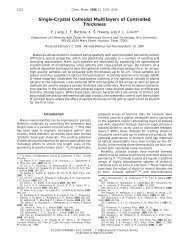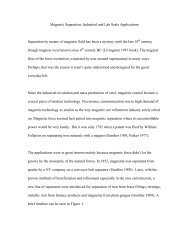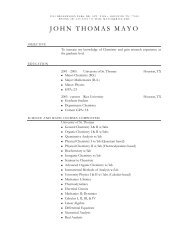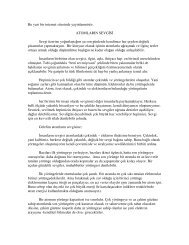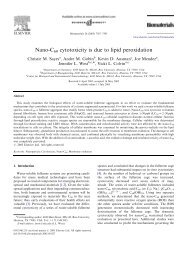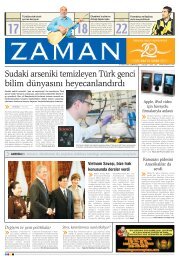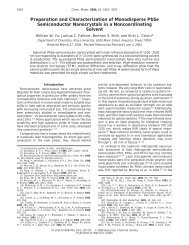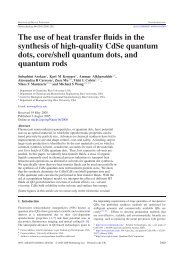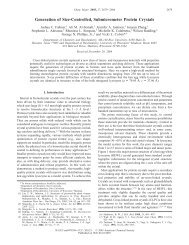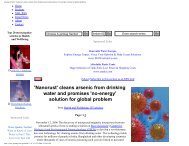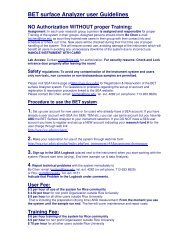Wet SEM Analysis of Quantum dot emulsions - Rice University
Wet SEM Analysis of Quantum dot emulsions - Rice University
Wet SEM Analysis of Quantum dot emulsions - Rice University
Create successful ePaper yourself
Turn your PDF publications into a flip-book with our unique Google optimized e-Paper software.
Test run 2: The effect is the same as in Test run 1. If the electron beam is pointed in the<br />
center <strong>of</strong> the Q<strong>dot</strong> emulsion the heat <strong>of</strong> beam causes bubbles. The gray background is the<br />
surface <strong>of</strong> the Emulsion. Except for the bubbles which appeared on the surface <strong>of</strong> the emulsion<br />
occasionally no detailed morphology <strong>of</strong> the emulsion or Aggregation <strong>of</strong> Q<strong>dot</strong>s can be obtained<br />
in this experimental set up. To download video (use Micros<strong>of</strong>t Media player) please go to we<br />
blink:<br />
Test run 3: To download video (use Micros<strong>of</strong>t Media player) please go to we blink:<br />
No useful data could be obtained from Test run 1 & 2. In this experimental set up the electron<br />
beam was pointed close to the edge <strong>of</strong> the stainless steel sample holder (see video). The edge<br />
<strong>of</strong> the sample holder served as reference point to help visualize the <strong>emulsions</strong> Interface to the<br />
holder. The following Pre-conditioning, Room temperature, Drying steps were applied to the<br />
Blank/ control emulsion to develop optimal experimental conditions to visualize details <strong>of</strong><br />
Q<strong>dot</strong> Aggregation in the subsequent Test run 4.<br />
Pre-conditioning: This step is necessary to ensure optimal humidity condition to preserve<br />
In this phase the Interface between emulsion to the left <strong>of</strong> the video (gray background, bubbles)<br />
and the sample Holder to the right (bright white area with ripples) can be clearly distinguished.<br />
Room temp.: This is the desired Characterization condition (Room temp. and humidity) for<br />
<strong>Analysis</strong>. In this phase violent bubbling (Popcorn effect) <strong>of</strong> the emulsion (left gray region) can<br />
be observed probably caused by the heat <strong>of</strong> the electron beam as it scans along the Interface.<br />
Zooming into the emulsion region revealed forming <strong>of</strong> the bubbles and the surface morphology<br />
<strong>of</strong> the emulsion droplets turned from a smooth gray surface (observed in Test run 1 & 2) into a<br />
“Strawberry” type shape. No details other than bubble forming could be obtained.<br />
Drying: This step was performed to check if the dried form <strong>of</strong> the emulsion reveals more <strong>of</strong><br />
the emulsion details. Temperature decrease to 273 K= 0º C, ~ 100% Humidity, 2.44 Torr<br />
Pressure. Apply Vacuum to dry sample. Morphology <strong>Analysis</strong> <strong>of</strong> emulsion. . In this phase<br />
enhanced violent bubbling <strong>of</strong> the emulsion (left gray region) can be observed probably caused<br />
by the vacuum and the heat <strong>of</strong> the electron beam as it scans along the Interface.<br />
Room temp. The “dried emulsion” was put back on Room temperature to check emulsion<br />
behavior. As the electron beam scans along the sample the “Strawberry” type <strong>of</strong> emulsion<br />
droplets developed and additional micro bubbles on the surface <strong>of</strong> droplets. No details other<br />
than additional bubble forming could be obtained.<br />
Test run 4: To download video (use Micros<strong>of</strong>t Media player) please go to we blink:<br />
The sample chamber conditions in Test run 3 were applied to the emulsion containing Q<strong>dot</strong>s in<br />
the hope that the different steps would visualize Q<strong>dot</strong>s and Aggregation <strong>of</strong> Q<strong>dot</strong>s in the<br />
emulsion.<br />
Pre-conditioning: This step is necessary to ensure optimal humidity condition to preserve<br />
In this phase the Interface between emulsion to the left <strong>of</strong> the video (gray Background,<br />
bubbles) and the sample Holder to the right (bright white area with ripples) can be clearly<br />
distinguished.<br />
Room temp.: This phase is the desired Characterization condition (Room temp. and humidity)<br />
for <strong>Analysis</strong>. Much less bubbling (Popcorn effect) <strong>of</strong> the emulsion (left gray region). More like<br />
a “Moon surface visual effect” can be observed probably caused by the heat <strong>of</strong> the electron<br />
beam as it scans along the Interface. Zooming into the emulsion region revealed forming <strong>of</strong>



